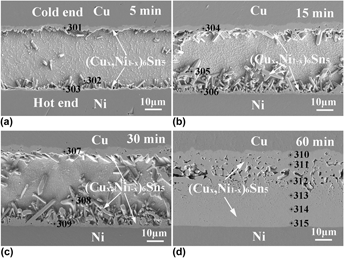Crossref Citations
This article has been cited by the following publications. This list is generated based on data provided by
Crossref.
Zhong, Y.
Zhao, N.
Dong, W.
Wang, Y.P.
and
Ma, H.T.
2018.
In situ study on the effect of Cu5Zn8 intermetallic layer on the Cu-Ni cross-interaction in Cu/Sn-9Zn/Ni interconnect under temperature gradient.
Materials Chemistry and Physics,
Vol. 216,
Issue. ,
p.
130.
Min, Kyung Deuk
Lee, Choong-Jae
Hwang, Byeong-Uk
Kim, Jae-Ha
Jang, Jun-Ho
and
Jung, Seung-Boo
2021.
Hybrid transient liquid phase sintering bonding of Sn-3.0Ag-0.5Cu solder with added Cu and Ni for Cu Ni bonding.
Applied Surface Science,
Vol. 551,
Issue. ,
p.
149396.
Lai, Yanqing
Chen, Shi
Ren, Xiaolei
Qiao, Yuanyuan
and
Zhao, Ning
2022.
Growth behavior and morphology evolution of interfacial (Cu,Ni)6Sn5 in (001)Cu/Sn/Ni micro solder joints.
Materials Characterization,
Vol. 186,
Issue. ,
p.
111803.
Lai, Yanqing
Chen, Shi
Ren, Xiaolei
Qiao, Yuanyuan
and
Zhao, Ning
2022.
Solid–liquid Interdiffusion Bonding of Cu/Sn/Ni Micro-joints with the Assistance of Temperature Gradient.
Acta Metallurgica Sinica (English Letters),
Vol. 35,
Issue. 11,
p.
1912.
Lai, Yanqing
and
Zhao, Ning
2022.
Study on the evolution of interfacial (Cu,Ni)6Sn5 and shear property of (111)Cu/Sn/Ni micro joints under isothermal and TG-bonding.
Intermetallics,
Vol. 147,
Issue. ,
p.
107614.
Lai, Yanqing
Xu, Ruisheng
Chen, Shi
Tang, Qianqi
Yu, Fengyun
and
Zhao, Ning
2023.
Rapid formation, grain refinement and shear property of high-temperature-stable full IMC joints.
Journal of Materials Research and Technology,
Vol. 24,
Issue. ,
p.
6146.
Gao, Xing
Zhang, Z.J.
Wei, Hong
Zhou, Xu
Shi, Quan
Wu, Yang
and
Chen, Lei Da
2024.
Effect of reflow temperature and solder size on Cu-Ni cross-interaction in the Cu/Sn/Ni micro solder joints.
Microelectronics International,
Vol. 41,
Issue. 1,
p.
9.
Chen, Chen
Zhang, Liang
Guo, Xing-Yu
Zhang, Jia-Min
and
Huang, Xi
2024.
Optimizing temperature gradient for rapid fabrication of Cu/Sn/Cu full intermetallic compounds joints via vacuum thermal compression bonding.
Journal of Materials Science: Materials in Electronics,
Vol. 35,
Issue. 12,
